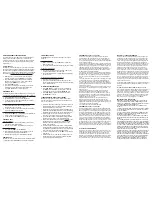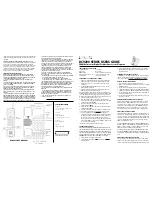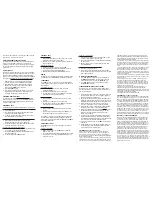
ADJUSTING HANDSET RECEIVE VOLUME
The handset has four (4) volume levels. To adjust the handset
volume, locate the volume up/down keys, located on the
handset, below the “
#
” key. Pressing the “minus”
(-)
key will
decrease the volume level, while pressing the “plus”
(+)
key
will increase it.
AUTO DIAL KEYS
The DC9100 series has either five (5) or ten (10) programmable
guest service (auto dial) keys, depending on the model you own.
These keys can be programmed to automatically dial telephone
numbers, or to activate telephone system features. To program the
auto dial keys (programming can only be done from base unit):
1. With the phone “on hook” (inactive) and the faceplate
removed, press the recessed
STORE
key (see diagram).
2. Enter the desired telephone number (up to 15 digits in
length) to be stored. To enter a “pause” in the number
string, press the
REDIAL
key as necessary.
3. Press the
STORE
key again.
4. Press the auto dial key where the number is to be stored.
Programming is now completed for that auto dial key.
To program additional keys, repeat this process.
RECEIVING A CALL
An audible ring and flickering red LED indicate an incoming call.
To answer the call using the handset while it is
not
on the base:
1. Pick up the handset and press the
ON
key.
2. The handset will go “off-hook” answering the call.
3. To end the call, place the handset in the base unit cradle, or
press the
OFF
key on the handset.
To answer the call using the handset while it is resting on the base:
1. Pick up the handset from the base. The phone will
automatically connect to the line.
2. To end the call, replace the handset in the base unit cradle,
or press the
OFF
key on the handset.
To answer the call using the speakerphone:
1. Press either the
LINE
key or the
SPKR
key. The speakerphone
will go “off-hook” answering the call.
2. To end the call, press the
SPKR
key to hang up.
PLACING A CALL
Using the handset:
1. Pick up the handset and press the
ON
key. Listen for dial
tone and dial the desired number.
2. After the call is complete, press the
OFF
key to hang up.
Using the speakerphone:
1. Press either the
LINE
key or the
SPKR
key.
2. Listen for dial tone, and dial the desired number, or press an
auto dial key to dial a preprogrammed number.
3. After the call is complete, press the
SPKR
key to hang up.
REDIAL/PAUSE
The DC9100 series can automatically redial the last number dialed.
On the handset, press the
REDIAL
key to redial the last number.
USING THE HOLD KEY
The
HOLD
key places the call on hold locally at the cordless
telephone.
To place a call on hold:
1. With a call active, press the red
HOLD
key on either the
handset or base unit.
2. The red line LED will slowly blink, indicating the call is on hold.
To remove a call from hold:
1. Press the line key of the call on hold. This will remove the
call from hold, making the call active again.
2. The red line LED will return to steady illumination, indicating
the line is active.
To change phones after placing a call on hold:
1. Place the call on hold as above.
2. Pick up the call at another telephone that is on the same
line. The telephone will activate the line and remove the hold
at the original telephone.
TO MUTE THE SPEAKERPHONE
1. Press the
MUTE
key on the base unit. The red LED above
the
MUTE
key will illuminate. The party on the other end
will not be able to hear you when the
MUTE
LED is lit.
2. Press the
MUTE
key again to turn off the mute feature.
The
MUTE
LED will go out.
CONVERTING FROM DESK TO WALL MOUNT
The DC9100 series can be adapted for wall mounting applica-
tions. The conversion is easiest to make when the handset and
cords are not connected.
1. Located on the handset cradle, above the speaker grill, is the
wall/desk mount clip. Remove this clip by firmly pushing it
upward towards the top of the phone.
2. Flip the clip over (top to bottom) so that the protruding edge is
towards the top of the phone and replace it in its slot. This edge
will hold the handset when the phone is mounted on the wall.
3. Turn the telephone over so the bottom is up, facing you.
Place it on a non-abrasive surface to prevent scratching.
4. Locate and remove the mounting bracket. Firmly push back
and pull up to remove two of the four retaining tabs.
5. Rotate the mounting bracket 180º degrees clockwise, so that
the mounting eyelet on the bracket is facing in the same
direction as the other mounting eyelet located on the
bottom of the telephone.
6. Insert the top two retaining tabs of the mounting brackets
into the mounting bracket slots (located near the middle of
the telephone). Then firmly push down to insert the retaining
tabs on the opposite side of the mounting bracket.
7. Connect a 15-foot RJ-45 cord into the
LINE
jack on the back
of the phone.
8. Turn the telephone over, and slide the telephone down onto
the mounting posts of the wall bracket. Ensure that both
eyelets line up with the mounting posts.
REQUIREMENTS OF PART 68 - FCC RULES
This device has been granted a registration number by the Federal
Communications Commission, under Part 68 rules and regulations for
direct connection to the telephone lines. In order to comply with these
FCC rules, the following instructions must be carefully read and applicable
portions followed completely:
1. Direct connection to the telephone lines may be made only through the
standard modular cord furnished, to the utility installed jack. No connection
may be made to party or coin phone lines. On the bottom of the phone is
a label that contains among other information, the FCC Registration
Number and the Ringer Equivalence number (REN) for this equipment. If
requested this information must be provided to the telephone company.
The
USOC Jack
for this equipment is
RJ11C
.
2. The telephone company, under certain circumstances, may temporarily
discontinue and make changes in facilities and services which may affect
the operation of the users' equipment: however, the user shall be given
adequate notice in writing to allow the user to maintain uninterrupted
service.
3. In certain circumstances, it may be necessary for the telephone company
to request information from you concerning the equipment which you
have connected to your telephone line. Upon request of the telephone
company, provide the FCC registration number and the ringer equivalence
number of the equipment which is connected to your line; this information
will be found on the device.
4. If any of your telephone equipment is not operating properly, you should
immediately remove it from the telephone line. It may cause harm to the
telephone network.
5. If the telephone company notes a problem, they may temporarily
discontinue service. When practical, they will notify you in advance
disconnection. If advance notice is not feasible, the telephone company
must; promptly notify you of such temporary discontinuance; afford the
opportunity to correct the condition; inform you of your rights to bring a
complaint to the FCC under their rules.
6. Repairs to the device may be made only by the manufacturer or an
authorized service agency. This applies at any time during and after
warranty. If unauthorized repair is performed, registration, connection to the
telephone lines and remainder of warranty period all become null and void.
7. This equipment is hearing aid compatible.
8. This telephone must be connected behind a PBX.
REQUIREMENTS OF PART 15 - FCC RULES
NOTE: This equipment has been tested and found to comply with the lim-
its for a Class B digital device, pursuant to Part 15 of the FCC Rules. These
limits are designed to provide reasonable protection against harmful inter-
ference in a residential installation. This equipment generates, uses, and
can radiate radio frequency energy and, if not installed and used in accor-
dance with the instruction, may cause harmful interference to radio com-
munications. However, there is not a guarantee that interference will not
occur in a particular installation. If this equipment does cause harmful
interference to radio or television reception, which can be determined by
turning the equipment off and on, the user is encouraged to try to correct
the interference by one or more of the following measures: Move the tele-
phone away from the receiver; Consult the dealer or an experienced
radio/TV technician for help. Any changes made by the user not approved
by the manufacturer can void the user's authority to operate the telephone.
FCC RF EXPOSURE INFORMATION
In August 1996, the Federal Communications Commission (FCC) of the
United States, with its action in Report and Order FCC 96-326, adopted
an updated safety standard for human exposure to radio frequency
electromagnetic energy emitted by FCC-regulated transmitters. Those
guidelines are consistent with the safety standard previously set by both
US and international standards bodies. This phone has been tested to
and complies with the FCC guidelines and these international standards.
INDUSTRY OF CANADA REQUIREMENTS
NOTICE: The Industry Canada label identifies certified equipment. This
certification means that the equipment meets certain telecommunica-
tions network protective operational and safety requirements as pre-
scribed in the appropriate Terminal Equipment Technical Requirements
documents. The department does not guarantee the equipment will
operate to the users satisfaction. Before installing this equipment, users
should ensure that it is permissible to be connected to the facilities of
the local telecommunications company. The equipment must also be
installed using an acceptable method of connection. The customer
should be aware that compliance with the above conditions may not
prevent degradation of service in some situations. Repairs to certified
equipment should be coordinated by a representative designated by the
supplier. Any repairs or alterations made by the user to this equipment,
or equipment malfunctions, may give the telecommunications company
cause to request the user to disconnect the equipment. Users should
ensure for their own protection that the electrical ground connections of
the power utility, telephone lines, and internal metallic water pipe sys-
tems, if present, are connected together. This precaution may be particu-
larly important in rural areas.
Caution: Users should not attempt to make such connections themselves, but
should contact the appropriate electric inspection authority or electrician, as
appropriate.
The Ringer Equivalence Number (REN) of this device is 0.7B.
Notice: The Ringer Equivalence Number (REN) assigned to each terminal
device provides an indication of the maximum number of terminals
allowed to be connected to a telephone interface. The termination on an
interface may consist of any combination of devices subject only to the
requirement that the sum of the Ringer Equivalence Numbers of all the
devices does not exceed 5. This telephone connects to the telephone
network under the connecting arrangement code
CA11A.
IMPORTANT SAFETY INSTRUCTIONS
WHEN USING YOUR TELEPHONE EQUIPMENT, BASIC SAFETY PRECAU-
TIONS SHOULD ALWAYS BE FOLLOWED TO REDUCE THE RISK OF FIRE,
ELECTRIC SHOCK AND INJURY TO PERSONS, INCLUDING THE FOLLOWING:
1. READ AND UNDERSTAND ALL INSTRUCTIONS.
2. FOLLOW ALL WARNINGS AND INSTRUCTIONS MARKED ON THE
PRODUCT.
3. UNPLUG THE PRODUCT FROM THE WALL OUTLET BEFORE CLEANING.
DO NOT USE LIQUID CLEANER OR AEROSOL CLEANERS. USE A DAMP
CLOTH FOR CLEANING.
4. DO NOT USE THIS PRODUCT NEAR WATER, FOR EXAMPLE, NEAR A
BATHTUB, WASH BOWL, KITCHEN SINK OR LAUNDRY TUB, IN A WET
BASEMENT, OR NEAR A SWIMMING POOL.
5. DO NOT PLACE THIS PRODUCT ON AN UNSTABLE CART, STAND OR
TABLE. THE PRODUCT MAY FALL, CAUSING SERIOUS DAMAGE TO THE
PRODUCT.
6. SLOTS AND OPENINGS IN THE CABINET AND THE BACK OF BOTTOM
ARE PROVIDED FOR VENTILATION, TO PROTECT IT FROM OVERHEATING.
THESE OPENINGS MUST NOT BE BLOCKED OR COVERED. THE OPENINGS
SHOULD NEVER BE BLOCKED BY PLACING THE PRODUCT ON THE BED,
SOFA, RUG OR ANY OTHER SIMILAR SURFACE. THIS PRODUCT SHOULD
NEVER BE PLACED NEAR OR OVER A RADIATOR OR HEAT REGISTER.
THIS PRODUCT SHOULD NOT BE PLACED IN A BUILT-IN INSTALLATION
UNLESS PROPER VENTILATION IS PROVIDED.
7. NEVER PUSH OBJECTS OF ANY KIND INTO THIS PRODUCT THROUGH
CABINET SLOTS AS THEY MAY TOUCH DANGEROUS VOLTAGE POINTS
OR SHORT OUT PARTS THAT COULD RESULT IN A RISK OF FIRE OR
ELECTRIC SHOCK. NEVER SPILL LIQUID OF ANY KIND ON THE PRODUCT.
8. TO REDUCE THE RISK OF ELECTRIC SHOCK DO NOT DISASSEMBLE
THIS PRODUCT. BUT TAKE IT TO A QUALIFIED SERVICE FACILITY IF
SERVICE OR REPAIR WORK IS REQUIRED. OPENING OR REMOVING
COVERS MAY EXPOSE YOU TO DANGEROUS VOLTAGES OR OTHER




